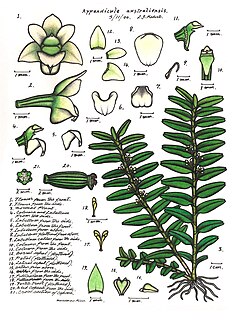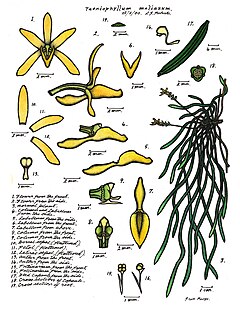
Sarcochilus falcatus, commonly known as the orange blossom orchid, is a small epiphytic or lithophytic orchid that is endemic to eastern Australia. It has up to eight, leathery leaves with fine teeth on the edges and up to twelve white to cream-coloured flowers with a white labellum that has orange and purple markings.

Podochilus australiensis, commonly known as the native stream orchid, is a species of epiphytic or lithophytic orchid. It has a fern-like appearance with many thin, twisted, glossy green leaves and clusters of up to six dull white or greenish flowers with a green labellum. It grows tropical North Queensland.
Chiloschista phyllorhiza, commonly known as the white starfish orchid, is a species of leafless epiphytic or lithophytic orchid that forms small clumps with many radiating, flattened green roots. A large number of short-lived, crystalline white, star-shaped flowers with a yellow labellum are arranged along thin, arching flowering stems. It occurs in northern parts of Australia where it grows in rainforest, swamps and near streams.

Luisia tristis, commonly known as the velvet orchid, is a species of epiphytic or lithophytic orchid with wiry stems often forming tangled clumps, cylindrical leaves and flowering stems with up to three green flowers with a dark red to dark maroon labellum. This orchid occurs in tropical Asia, New Guinea, Australia and some islands of the Western Pacific Ocean.

Micropera fasciculata, commonly known as the pale dismal orchid, is a species of epiphytic or lithophytic orchid with wiry stems forming large, tangled clumps. It has stiff, leathery leaves and flowering stems with between ten and twenty cream-coloured flowers with a white labellum. This orchid occurs in New Guinea, Queensland, the Solomon Islands and New Caledonia.

Plectorrhiza brevilabris, commonly known as the small tangle orchid, is an epiphytic or lithophytic orchid endemic to Australia. It has many coarse, wiry roots, between three and nine bright green leaves and up to twenty green, star-shaped flowers with reddish brown markings and a white patch on the labellum. It grows in rainforest on trees, shrubs and occasionally on rocks and occurs on the near coastal ranges of eastern Queensland.

Pomatocalpa macphersonii, commonly known as the blotched bladder orchid, is an epiphytic or lithophytic orchid with thick, cord-like roots, between two and eight dark green, leathery leaves and up to thirty cup-shaped, yellow flowers with red blotches and a white labellum with red blotches. It usually grows on rainforest trees and is found in New Guinea and tropical North Queensland, Australia.

Pomatocalpa marsupiale, commonly known as the branched bladder orchid, is an epiphytic or lithophytic orchid that forms large clumps. It has many thick roots, branched stems, many strap-like, leathery leaves and up to many upward-facing green flowers with a cream-coloured or yellowish labellum. It usually grows on high on rainforest trees and is found between Sulawesi and tropical North Queensland, Australia.

Robiquetia gracilistipes, commonly known as the large pouched orchid, is an epiphytic or lithophytic orchid from the family Orchidaceae that forms large, hanging, straggly clumps. It has long, thick, roots, a single stem, many thick, leathery leaves and up to forty cream-coloured, pale green or brownish flowers with red spots and a three-lobed labellum. It grows on trees and rocks in rainforest, usually in bright light. It is found in Malesia including New Guinea, the Solomon Islands and tropical North Queensland, Australia.
Saccolabiopsis armitii, commonly known as the spotted pitcher orchid, is an epiphytic orchid from the family Orchidaceae. It has a short stem, coarse, wiry roots, between three and six crowded, curved leaves and up to fifty yellowish green flowers with red markings and a white labellum. It usually grows in coastal scrub to rainforest in New Guinea and tropical North Queensland, Australia.

Taeniophyllum lobatum, commonly known as the yellow ribbonroot, is a species of leafless epiphytic or lithophytic orchid that forms small clumps. It has short stems, flattened pale to greyish green roots pressed against the substrate on which it is growing and usually two pale to bright yellow flowers. It only occurs in tropical North Queensland.

Taeniophyllum malianum, commonly known as the tangled ribbonroot, is a species of leafless epiphytic or lithophytic orchid that forms tangled clumps. It has flattened green roots with irregular white spots and pressed against the substrate on which it is growing. There are up to fifteen fragrant yellow, short-lived flowers with up to three open at the same time. It only occurs in tropical North Queensland and in New Guinea.
Thrixspermum carinatifolium, commonly known as the Christmas Island hairseed, is an epiphytic orchid with flattened, straggly stems that form clumps with many branching aerial roots. It has flattened fleshy leaves arranged in two ranks along the stems and white or yellowish, widely opening flowers. This orchid occurs from Peninsular Malaysia to Christmas Island, an Australian territory.

Thrixspermum congestum, commonly known as the cupped hairseed, is an epiphytic or lithophytic orchid that forms small clumps with many thin roots, up to fifteen leathery leaves and many star-shaped white or cream-coloured flowers. This orchid occurs from Papuasia to northern Australia.

Trachoma speciosum, commonly known as the showy spectral orchid, is an epiphytic or lithophytic orchid that forms clumps with many thick, cord-like roots, between four and eight thick, leathery leaves and many short-lived, cream-coloured flowers with an orange and white labellum. This orchid occurs in tropical North Queensland.

Trachoma stellatum, commonly known as the starry spectral orchid, is an epiphytic or lithophytic clump-forming orchid with many thick roots. It has between three and eight thick, leathery leaves and many short-lived, cream-coloured flowers with purple markings and a yellow-tipped labellum. This orchid occurs in tropical North Queensland.

Trichoglottis australiensis, commonly known as the weeping cherub orchid, is an epiphytic or lithophytic clump-forming orchid. It has thick, cord-like roots, flattened, branching stems, many thick, leathery, glossy leaves and between two and six creamy yellow flowers with reddish blotches. This orchid only occurs in tropical North Queensland.

Vanda hindsii, commonly known as the native strap orchid or the Cape York vanda,is a large epiphytic or lithophytic clump-forming orchid. It has thick, white, cord-like roots, branching stems, many thick, leathery, strap-like leaves and between three and seven shiny brown flowers with greenish to yellow markings and a white labellum. This orchid occurs in New Guinea and tropical North Queensland.
Bryobium eriaeoides, commonly known as the brittle urchin orchid, is an epiphytic or lithophytic clump-forming orchid that has fleshy, green pseudobulbs, each with two leaves and between three and twelve cup-shaped white to purplish flowers but that sometimes remain closed. This orchid occurs in New Guinea and Queensland.

Pholidota imbricata, commonly known as the common rattlesnake orchid or necklace orchid, is a plant in the orchid family and is a clump-forming epiphyte or lithophyte with crowded pseudobulbs. Each pseudobulb has a single pleated, leathery leaf and up to sixty white, cream-coloured or greenish, cup-shaped flowers in two ranks along a wiry flowering stem. There is a large, papery bract at the base of each flower. This species is native to areas from tropical and subtropical Asia to the southwest Pacific.















